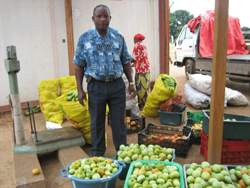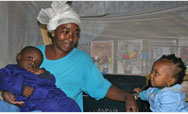You are here » Home » Telling Our Story
Case Study
Farmers switch from subsistence farming to high value crops
Village Chief Harvests High Value Crops

| |
Photo: ACDI/VOCA
|
|
Simao Congo, a village chief in Liambo, Angola, has learned new methods of farming and marketing through USAID’s program.
“I didn’t believe that this project would help us in the beginning. I have lived here all of my life and have seen many projects come and go, but [this] project has brought new knowledge and a regular, monthly income for my family,” said Liambo Village Chief Simão Congo.
|
Challenge
Angola’s 27-year civil war, which ended in 2002, devastated the country’s agriculture sector. Before the war, small farms produced enough goods to meet national needs and even have plenty of maize, sugar, coffee, sisal, and bananas left for export. Today, Angola imports much of its food. The war displaced some 4.7 million, destroyed social and government structures, ruined basic infrastructure, and left a legacy of deadly landmines. Despite exports of $12.76 billion in crude and refined petroleum, gas, diamonds, coffee, sisal, fish, timber, and cotton, Angola ranks near the very bottom of almost every social and economic indicator.
Initiative
With help from USAID and Chevron, some 470 farms are changing their agricultural techniques and planting schedules to respond to market demand and move from subsistence to high-value crops. The initiative, run in partnership with a consortium of oil companies drilling in Cabinda, also provides farmers and produce suppliers with weekly training in business planning. Simão Congo, a leader in the village of Liambo, is one of these farmers. For 20 years, he has been growing produce to feed his family and sell at local markets. Now, he has expanded his crops to include all-season tomatoes, green peppers, and cucumbers popular in restaurant salad bars and households in Cabinda City. In addition to improving his own farm, Congo founded the Cabinda Farmers’ Association, which links farmers with buyers and helps farmers fetch higher prices for crops.
Results
The initiative has been very successful. In less than 18 months, Congo made weekly produce deliveries with a total value of $6,731. “I didn’t believe that this project would help us in the beginning. I have lived here all of my life and have seen many projects come and go, but [this] project has brought new knowledge and a regular, monthly income for my family. My farm income has increased, since these crops sell for up to $3 per kilogram,” said Congo.
Print-friendly version of this page (455kb - PDF)
Click here for high-res photo
Back to Top ^ | 

